Physical Address
304 North Cardinal St.
Dorchester Center, MA 02124
Physical Address
304 North Cardinal St.
Dorchester Center, MA 02124
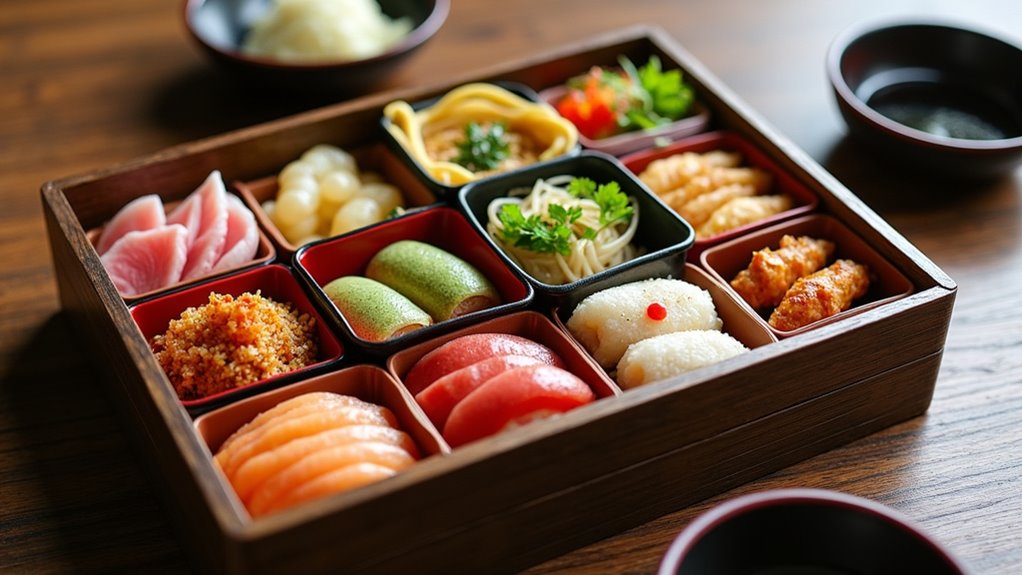
Japanese food culture captivates with nine extraordinary culinary treasures that showcase seasonal artistry and time-honored traditions.
Japanese cuisine offers a stunning variety of dishes that reflect the country’s reverence for nature and seasonal ingredients. You’ll discover iconic seafood traditions like sushi and unagi, comforting bowls of regional ramen, and the artistic presentations of kaiseki ryori. Don’t miss tempura’s crispy perfection, okonomiyaki’s savory satisfaction, Japanese curry’s unique character, or the social joy of yakitori skewers. These nine culinary treasures showcase why Japan’s food culture enthralls food lovers worldwide.
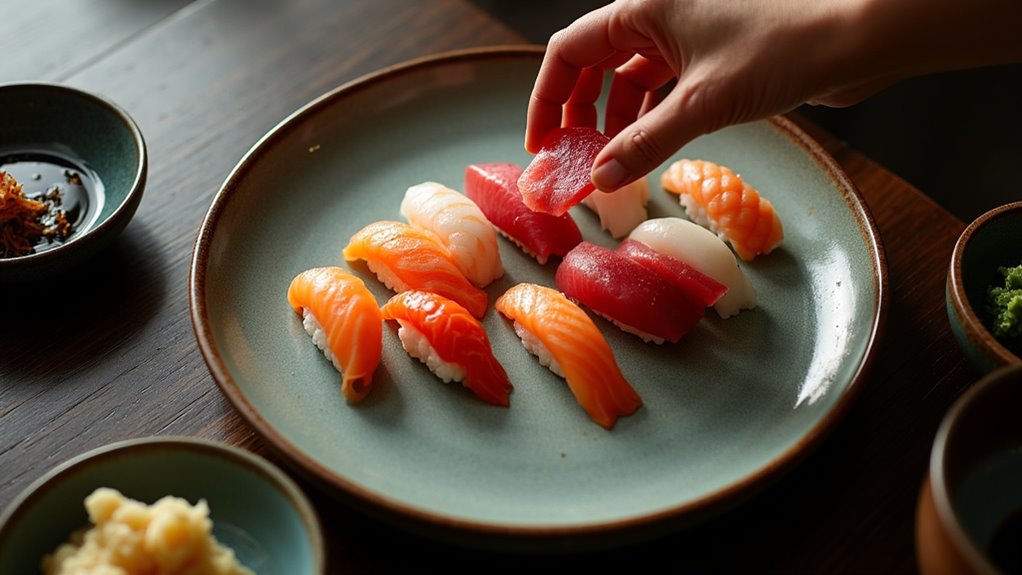
While many think of sushi as simply raw fish on rice, its history tells a far more complex story of innovation and cultural adaptation. Originally developed in Southeast Asia as a preservation method, sushi arrived in Japan around 300 BCE, where the fermented rice was initially discarded after preserving the fish.
By the Edo period (1603-1867), everything changed when vinegar replaced fermentation, transforming sushi into popular street food. This shift was facilitated by the widespread use of sake-based vinegar which had been a traditional practice in Japan for centuries. Hanaya Yohei’s invention of nigiri-zushi around 1824 revolutionized the cuisine, creating what you’d recognize today.
You’ll find various styles now: nigiri (hand-pressed), maki (rolled), chirashi (scattered), and inari (tofu pocket). Each requires meticulous preparation from chefs who’ve spent years mastering rice seasoning, knife skills, and seafood selection.
Though typically associated with Japan today, ramen’s journey begins in China with the noodle dish lāmiàn before finding its way to Japanese shores in the late 19th century. Since then, it’s evolved into a cultural icon with distinct regional styles that showcase Japan’s culinary creativity.
When you explore the world of ramen, you’ll discover:
Each bowl tells a story of local ingredients, traditions, and community. The invention of instant noodles by Momofuku Ando in 1958 helped propel ramen to even greater popularity throughout Japan and eventually worldwide.
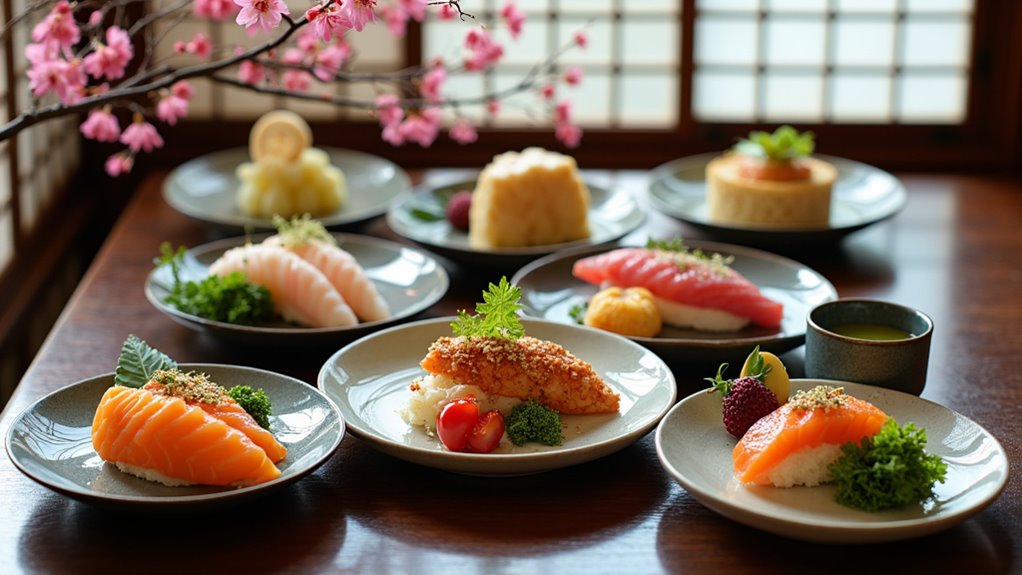
As Japan’s most revered culinary art form, kaiseki ryori transforms dining into a sublime multi-sensory experience that celebrates seasonality, precision, and mindfulness.
This sophisticated cuisine evolved from humble tea ceremony meals into haute cuisine, influenced by Buddhist shōjin ryōri principles. When you experience kaiseki, you’ll enjoy between seven and fourteen meticulously crafted courses, each showcasing different traditional cooking methods.
You’ll find kaiseki served in ryokans and specialized restaurants, where chefs create personalized menus using the freshest seasonal ingredients. Every dish tells a story through its artistic presentation, reflecting Japan’s deep connection with nature. The meal typically begins with an aperitif (shokuzen-shu) to stimulate the appetite before the procession of carefully sequenced courses.
The unhurried pace allows you to savor each course fully, creating a dining experience that honors centuries of culinary tradition while embracing thoughtful innovation.
When Portuguese Jesuits arrived in 16th century Japan, they brought more than just Christianity—they introduced a cooking technique that would transform into one of Japan’s most beloved culinary treasures.
You’ll recognize authentic tempura by its impossibly light, crisp coating that perfectly preserves the natural flavors of its ingredients. What began as riverside street food in Edo has evolved into an art form with distinctive characteristics:
This delicate balance of Western technique and Japanese sensibility exemplifies Japan’s genius for adapting foreign influences into something uniquely their own. The name “tempura” itself derives from the Latin word “tempora,” reflecting the Ember Days when Catholics abstained from meat and ate fish instead.
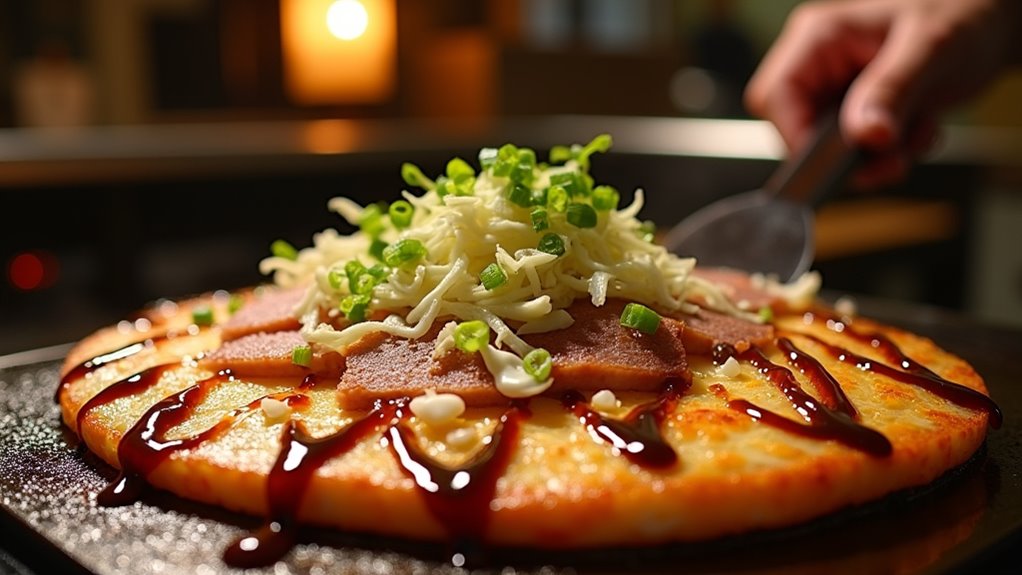
If you’ve ever wandered through Japanese food markets or neighborhood streets, you’ve likely encountered the mouthwatering aroma of okonomiyaki sizzling on a hot grill. This beloved dish evolved from simple Edo-period sweet pancakes into the regional sensation it’s today.
You’ll find distinct variations across Japan—Osaka’s version incorporates savory tororo, while Hiroshima’s signature style features stacked layers topped with noodles and eggs. The Hiroshima style uses three to four times more cabbage than the Kansai version, creating its distinctive height and texture. Tokyo offers the runnier monjayaki, eaten with small spatulas.
The beauty of okonomiyaki lies in its versatility—cabbage and batter form the base, but you’re encouraged to add whatever toppings you prefer. Finished with Worcestershire sauce, mayo, and bonito flakes, it’s a communal food that brings people together, especially in Hiroshima, Japan’s unofficial okonomiyaki capital.
Japanese curry tells a fascinating story of cultural adaptation that’s quite different from the regional diversity of okonomiyaki. This now-beloved comfort food arrived during the Meiji era (1868-1912) through British naval influence and transformed from an exotic Western luxury into a Japanese staple.
What makes Japanese curry uniquely Japanese:
You’ll find curry everywhere in Japan today, from school lunches to specialty restaurants, each serving this distinctly Japanese interpretation. The Japanese have embraced curry so thoroughly that it has evolved into numerous regional variations like Hokkaido’s soup curry and Yokosuka’s navy curry, cementing its status as a true national food of Japan.
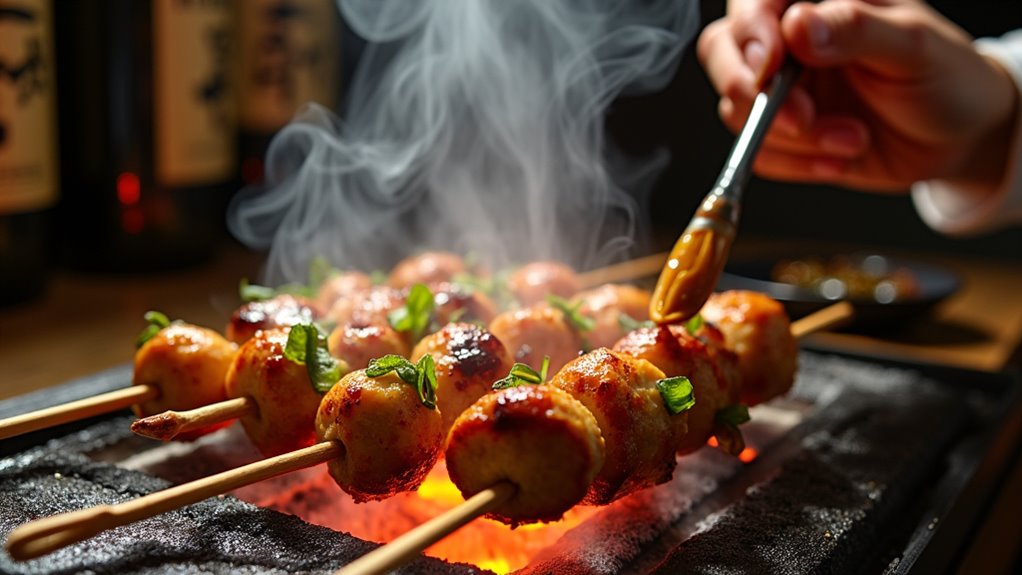
From savory chicken thigh to succulent beef tongue, yakitori and kushiyaki skewers represent one of Japan’s most beloved culinary traditions. While yakitori specifically refers to grilled chicken skewers, kushiyaki encompasses a broader range of ingredients including various meats, seafood, and vegetables.
You’ll find these delicious skewers in izakayas across Japan, typically served with either shio (salt) or tare (sweetened soy glaze). The preparation method—grilling over charcoal—creates a distinctive smoky flavor that perfectly complements an ice-cold draft beer. Yakitori involves chicken pieces cut into 1-2 inch cubes and carefully threaded onto skewers before grilling.
Each region boasts its own specialties, from coastal areas featuring seafood skewers to inland regions showcasing local vegetables. When you’re sharing skewers with friends at an izakaya, you’re participating in a social dining experience that’s central to Japanese food culture.
While grilled skewers offer a casual dining experience, unagi represents a more refined culinary tradition in Japan. The preparation of freshwater eel follows meticulous techniques, beginning with the ikejime method that guarantees ideal flavor and texture.
The classic kabayaki style transforms eel into a delicacy through:
You’ll typically find unagi served as unadon (over rice) in a donburi bowl. This nutritious dish holds cultural significance in Japan, symbolizing good luck and prosperity, especially during summer months when freshwater eel is seasonally available. Proper preparation requires thoroughly removing eel slime to ensure the cleanest flavor profile and optimal texture in the finished dish.
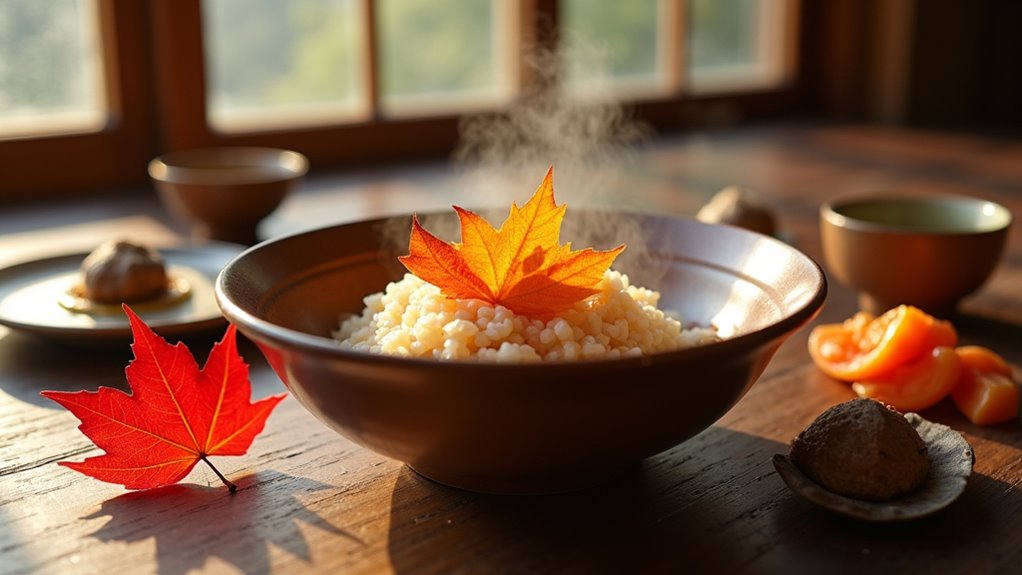
At the heart of Japanese cuisine lies the profound concept of shun, where ingredients are celebrated at their peak season for ideal flavor and nutritional value. This practice reflects Buddhist and Shinto influences that emphasize harmony with nature.
Shun guides Japanese cooking by honoring ingredients at their seasonal peak—a delicious expression of spiritual harmony with nature.
You’ll notice Japanese menus transform with the seasons—summer brings chilled dishes with cucumbers and peaches, while fall introduces matsutake mushrooms and kabocha squash. Winter and spring offer their own distinct flavors. Spring celebrations like hanami festivals feature special foods centered around cherry blossom viewing, with seasonal ingredients like snow peas and clams showcased in traditional dishes.
The seasonal approach extends beyond taste to presentation, where dishes are artfully arranged with seasonal elements. When you dine at traditional restaurants, especially kaiseki establishments, you’re experiencing a centuries-old tradition that connects food to time and place.
This seasonal mindset also promotes sustainability by favoring locally-sourced ingredients over imported options.
You’ve just glimpsed Japan’s culinary wonders, yet you’ve barely scratched the surface! While you’re dreaming of sushi perfection, countless family-run izakayas are serving dishes you’ve never heard of. Isn’t it ironic? The more you learn about Japanese cuisine, the more you realize how little you know. Don’t wait—your next meal could be the one that transforms your understanding of food forever!